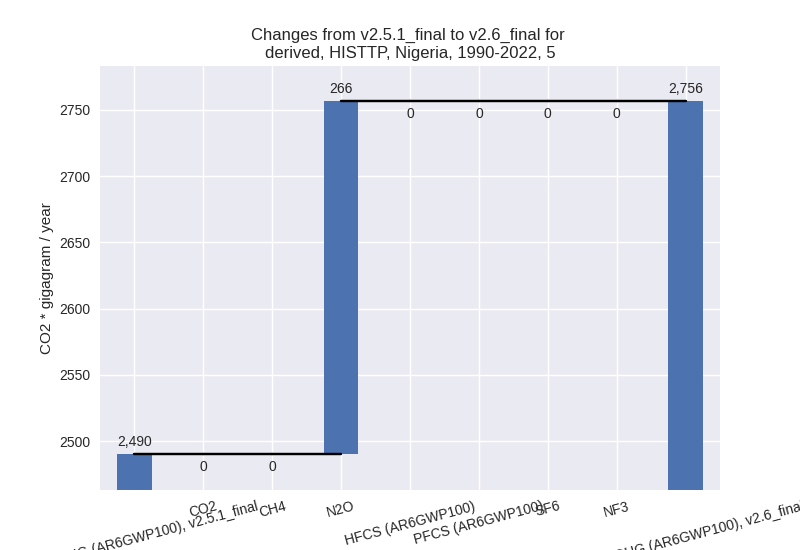Changes in PRIMAP-hist v2.6_final compared to v2.5.1_final for Nigeria
2024-09-24
Johannes Gütschow
Change analysis for Nigeria for PRIMAP-hist v2.6_final compared to v2.5.1_final
Overview over emissions by sector and gas
The following figures show the aggregate national total emissions excluding LULUCF AR6GWP100 for the country reported priority scenario. The dotted linesshow the v2.5.1_final data.
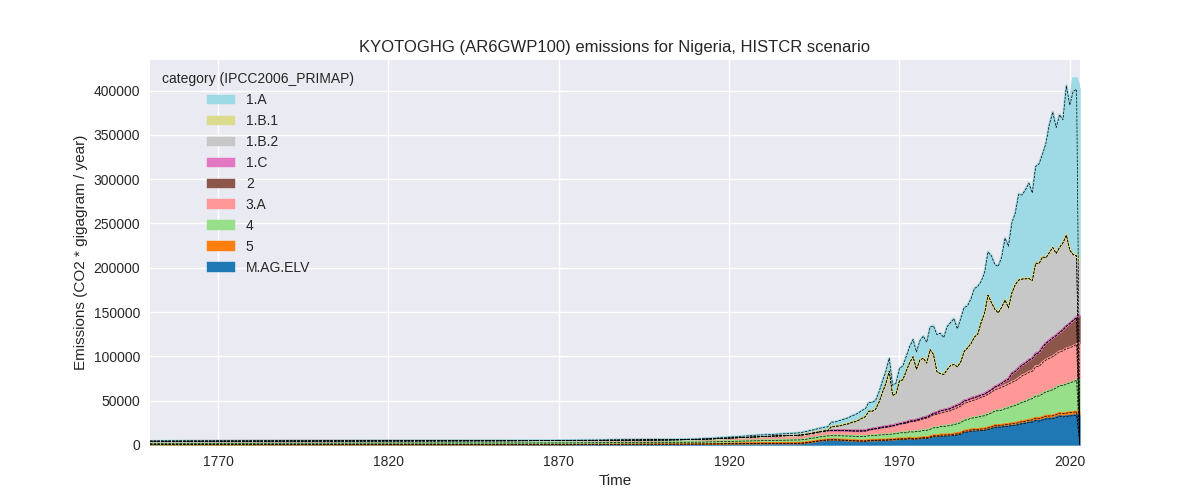
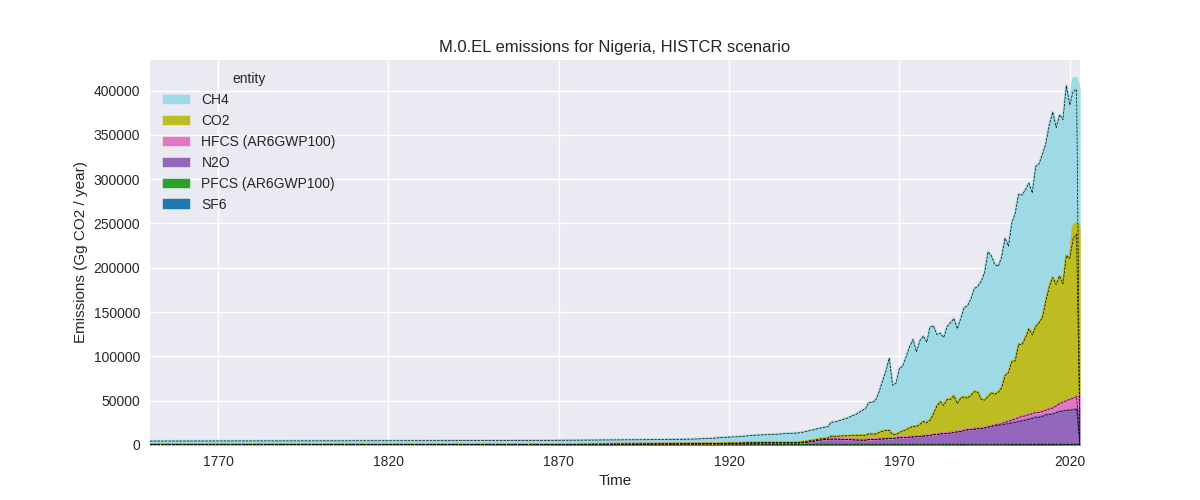
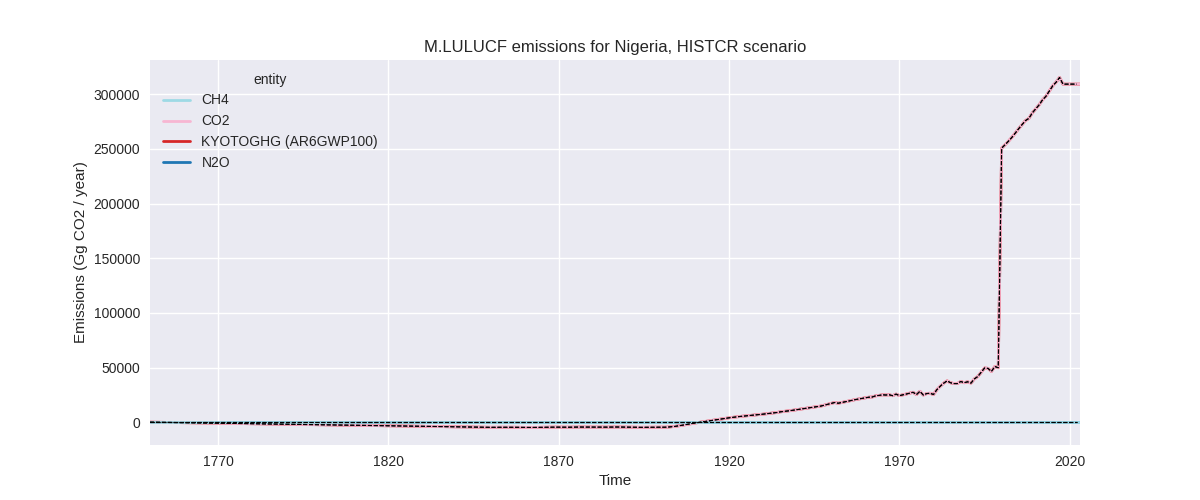
The following figures show the aggregate national total emissions excluding LULUCF AR6GWP100 for the third party priority scenario. The dotted linesshow the v2.5.1_final data.
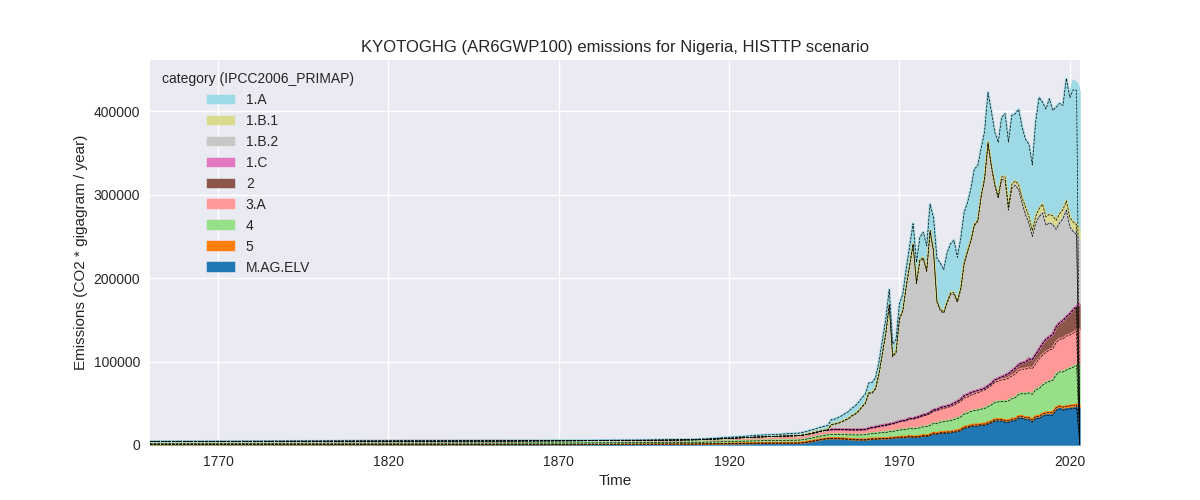
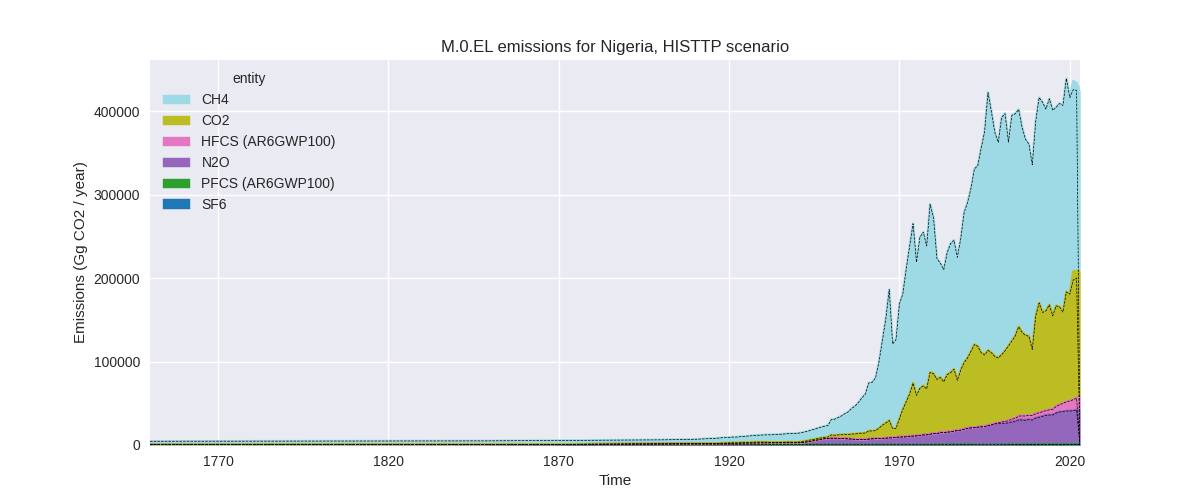
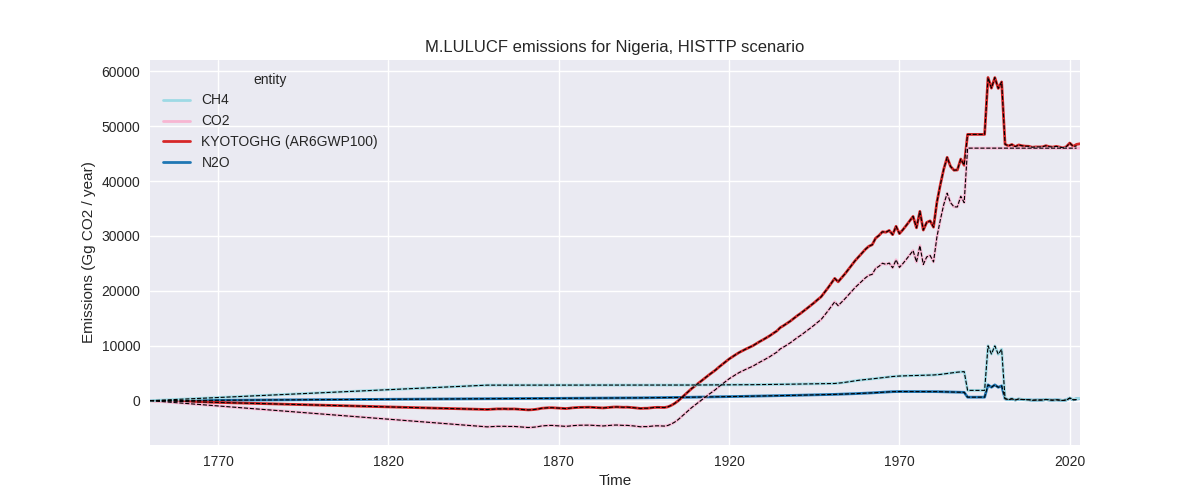
Overview over changes
In the country reported priority scenario we have the following changes for aggregate Kyoto GHG and national total emissions excluding LULUCF (M.0.EL):
- Emissions in 2022 have changed by 3.1%% (12419.49 Gg CO2 / year)
- Emissions in 1990-2022 have changed by 0.4%% (1142.79 Gg CO2 / year)
In the third party priority scenario we have the following changes for aggregate Kyoto GHG and national total emissions excluding LULUCF (M.0.EL):
- Emissions in 2022 have changed by 2.1%% (9001.83 Gg CO2 / year)
- Emissions in 1990-2022 have changed by 0.2%% (849.56 Gg CO2 / year)
Most important changes per scenario and time frame
In the country reported priority scenario the following sector-gas combinations have the highest absolute impact on national total KyotoGHG (AR6GWP100) emissions in 2022 (top 5):
- 1: 1.A, CO2 with 11656.37 Gg CO2 / year (7.1%)
- 2: 1.B.2, CO2 with 429.15 Gg CO2 / year (12.9%)
- 3: 4, CH4 with 255.06 Gg CO2 / year (0.9%)
- 4: 2, HFCS (AR6GWP100) with 205.69 Gg CO2 / year (1.5%)
- 5: 4, N2O with -163.86 Gg CO2 / year (-2.3%)
In the country reported priority scenario the following sector-gas combinations have the highest absolute impact on national total KyotoGHG (AR6GWP100) emissions in 1990-2022 (top 5):
- 1: 1.A, CO2 with 774.42 Gg CO2 / year (1.0%)
- 2: 5, N2O with 266.32 Gg CO2 / year (10.7%)
- 3: 1.B.2, CO2 with 85.48 Gg CO2 / year (3.0%)
- 4: 4, N2O with -27.24 Gg CO2 / year (-0.6%)
- 5: 4, CH4 with 24.00 Gg CO2 / year (0.1%)
In the third party priority scenario the following sector-gas combinations have the highest absolute impact on national total KyotoGHG (AR6GWP100) emissions in 2022 (top 5):
- 1: 1.A, CO2 with 8396.72 Gg CO2 / year (7.1%)
- 2: 4, CH4 with 350.62 Gg CO2 / year (0.8%)
- 3: 2, HFCS (AR6GWP100) with 205.69 Gg CO2 / year (1.5%)
- 4: 4, N2O with 60.84 Gg CO2 / year (2.8%)
- 5: 1.B.2, CO2 with -49.12 Gg CO2 / year (-0.5%)
In the third party priority scenario the following sector-gas combinations have the highest absolute impact on national total KyotoGHG (AR6GWP100) emissions in 1990-2022 (top 5):
- 1: 1.A, CO2 with 557.86 Gg CO2 / year (0.9%)
- 2: 5, N2O with 266.32 Gg CO2 / year (10.7%)
- 3: 4, N2O with 6.37 Gg CO2 / year (0.4%)
- 4: 2, HFCS (AR6GWP100) with 6.23 Gg CO2 / year (0.1%)
- 5: 1.B.2, CO2 with -3.99 Gg CO2 / year (-0.0%)
Notes on data changes
Here we list notes explaining important emissions changes for the country. ’' means that the following text only applies to the TP time series, while means that it only applies to the CR scenario. Otherwise the note applies to both scenarios.
- We have no new country reported data for Nigeria.
- Changes in CR and TP time series are due to updated EI data for energy CO2.
- Changes in sectors 4 and 5 are due to the removal of FAOSTAT data (CR, TP).
Changes by sector and gas
For each scenario and time frame the changes are displayed for all individual sectors and all individual gases. In the sector plot we use aggregate Kyoto GHGs in AR6GWP100. In the gas plot we usenational total emissions without LULUCF. ## country reported scenario
2022
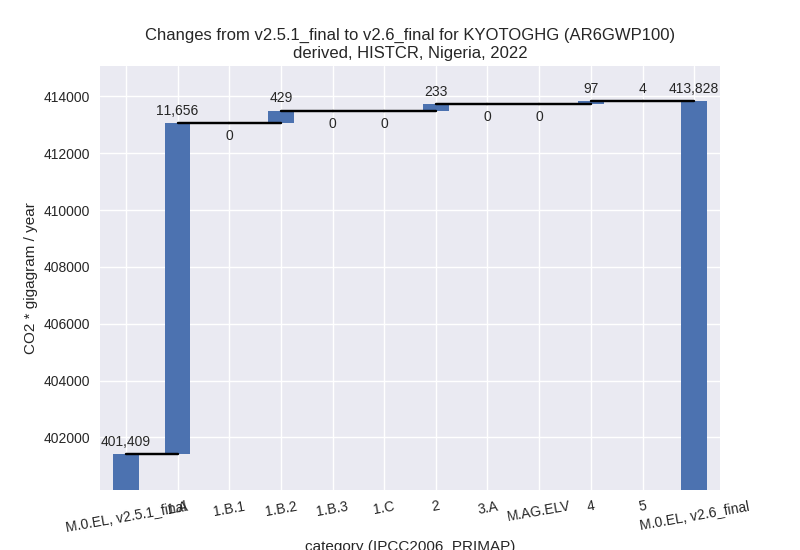
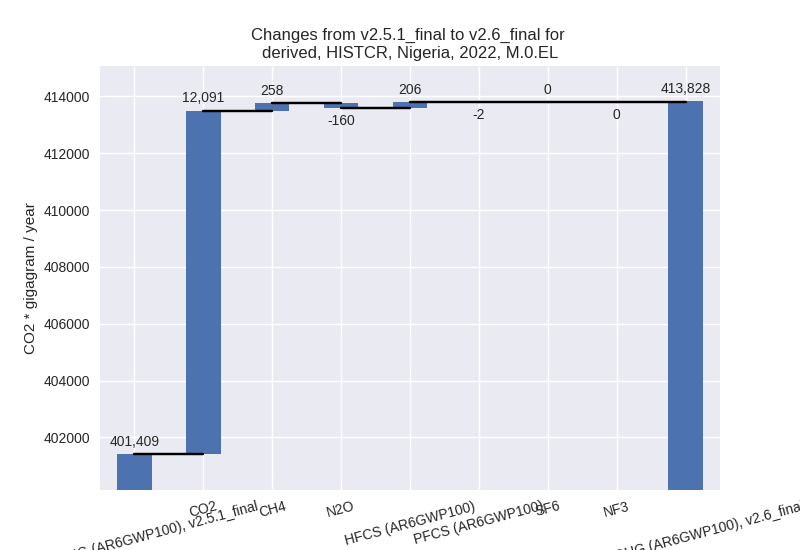
1990-2022
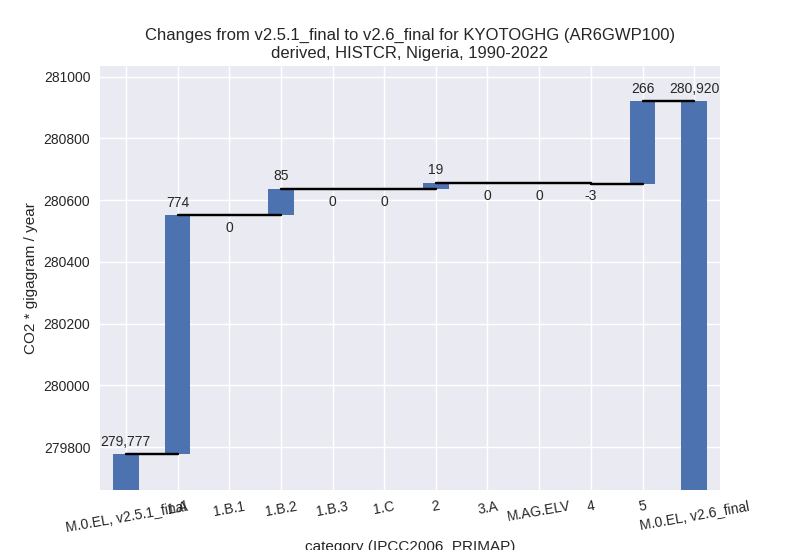
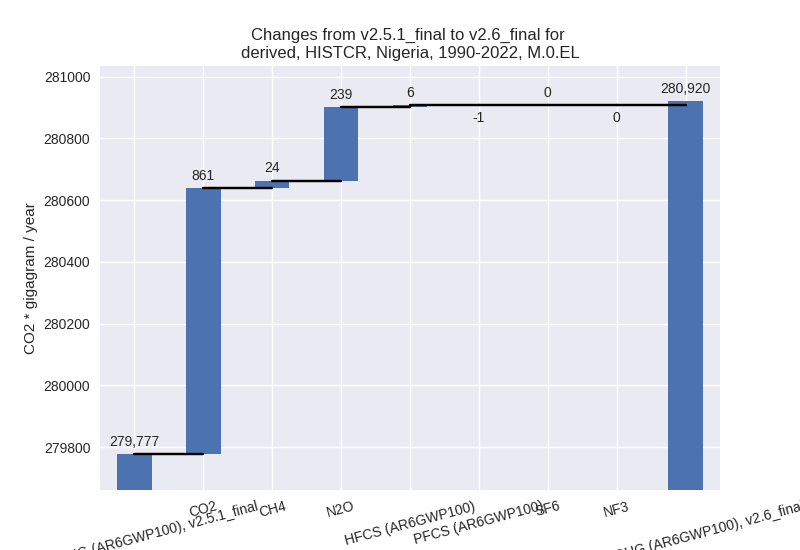
third party scenario
2022
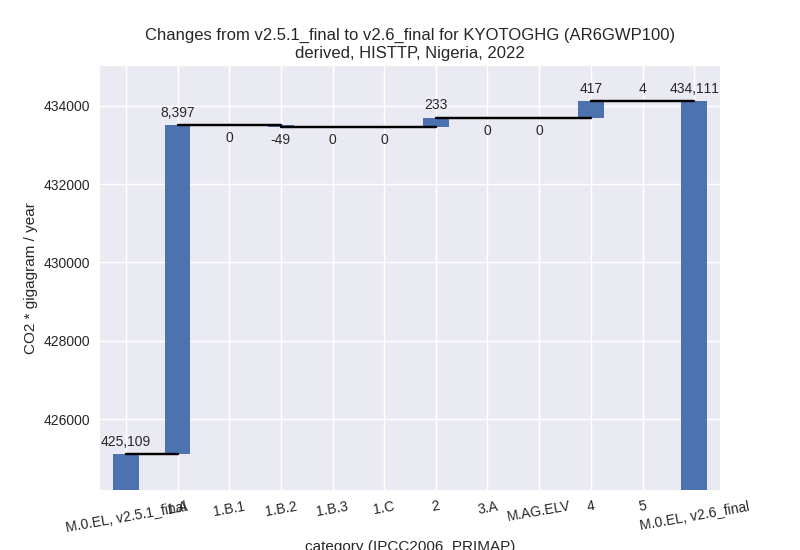

1990-2022
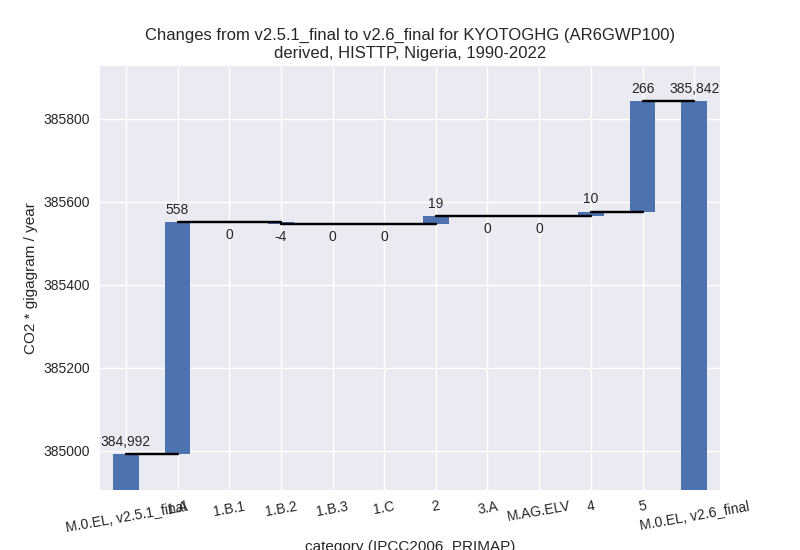
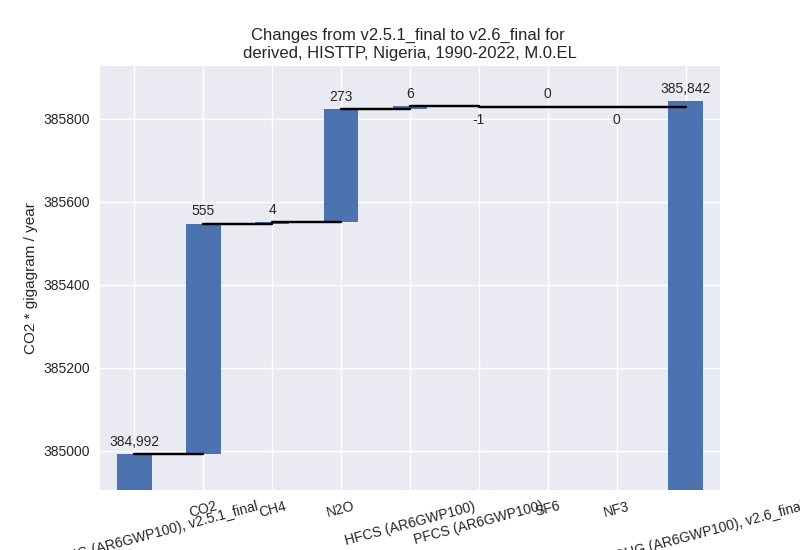
Detailed changes for the scenarios:
country reported scenario (HISTCR):
Most important changes per time frame
For 2022 the following sector-gas combinations have the highest absolute impact on national total KyotoGHG (AR6GWP100) emissions in 2022 (top 5):
- 1: 1.A, CO2 with 11656.37 Gg CO2 / year (7.1%)
- 2: 1.B.2, CO2 with 429.15 Gg CO2 / year (12.9%)
- 3: 4, CH4 with 255.06 Gg CO2 / year (0.9%)
- 4: 2, HFCS (AR6GWP100) with 205.69 Gg CO2 / year (1.5%)
- 5: 4, N2O with -163.86 Gg CO2 / year (-2.3%)
For 1990-2022 the following sector-gas combinations have the highest absolute impact on national total KyotoGHG (AR6GWP100) emissions in 1990-2022 (top 5):
- 1: 1.A, CO2 with 774.42 Gg CO2 / year (1.0%)
- 2: 5, N2O with 266.32 Gg CO2 / year (10.7%)
- 3: 1.B.2, CO2 with 85.48 Gg CO2 / year (3.0%)
- 4: 4, N2O with -27.24 Gg CO2 / year (-0.6%)
- 5: 4, CH4 with 24.00 Gg CO2 / year (0.1%)
Changes in the main sectors for aggregate KyotoGHG (AR6GWP100) are
- 1: Total sectoral emissions in 2022 are 269815.26
Gg CO2 / year which is 65.2% of M.0.EL emissions. 2022 Emissions have
changed by 4.7% (12085.52 Gg CO2 /
year). 1990-2022 Emissions have changed by 0.5% (859.90 Gg CO2 / year). For 2022 the
changes per gas
are:
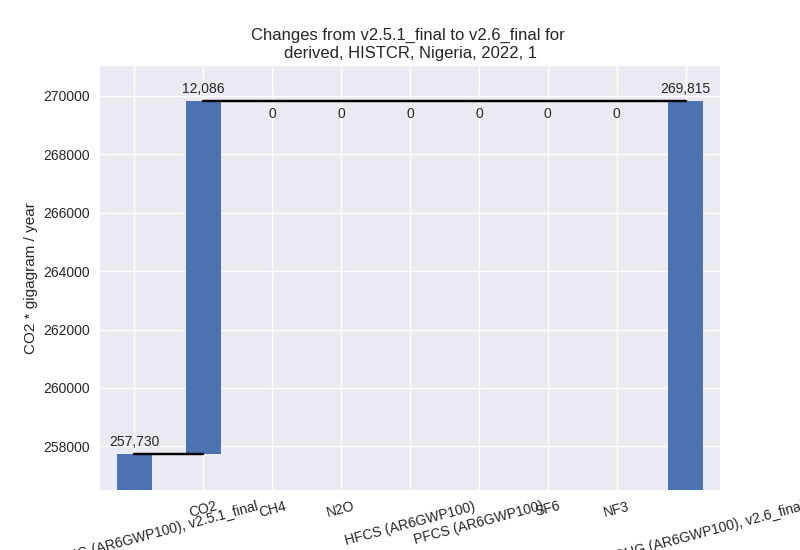
The changes come from the following subsectors:- 1.A: Total sectoral emissions in 2022 are 199606.30
Gg CO2 / year which is 74.0% of category 1 emissions. 2022 Emissions
have changed by 6.2% (11656.37 Gg
CO2 / year). 1990-2022 Emissions have changed by 0.8% (774.42 Gg CO2 / year). For 2022 the
changes per gas
are:
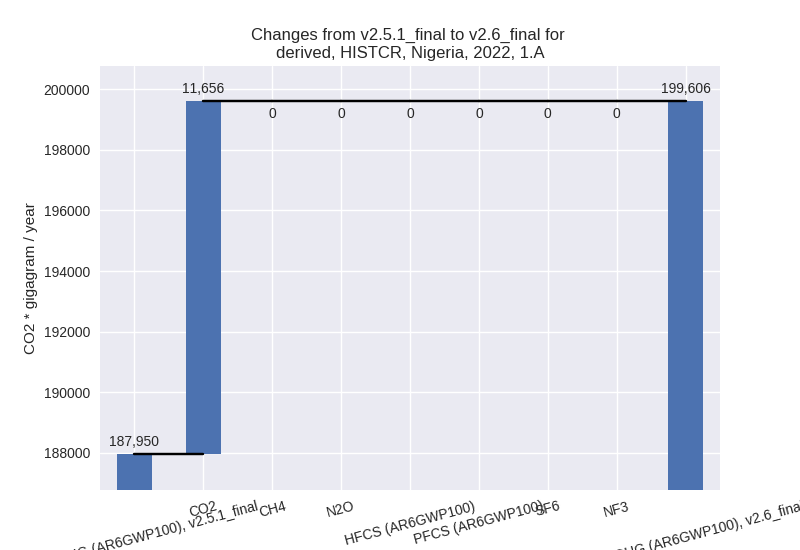
There is no subsector information available in PRIMAP-hist. - 1.B.1: Total sectoral emissions in 2022 are 174.97 Gg CO2 / year which is 0.1% of category 1 emissions. 2022 Emissions have changed by 0.0% (0.00 Gg CO2 / year). 1990-2022 Emissions have changed by 0.0% (0.00 Gg CO2 / year).
- 1.B.2: Total sectoral emissions in 2022 are 70033.99 Gg CO2 / year which is 26.0% of category 1 emissions. 2022 Emissions have changed by 0.6% (429.15 Gg CO2 / year). 1990-2022 Emissions have changed by 0.1% (85.48 Gg CO2 / year).
- 1.A: Total sectoral emissions in 2022 are 199606.30
Gg CO2 / year which is 74.0% of category 1 emissions. 2022 Emissions
have changed by 6.2% (11656.37 Gg
CO2 / year). 1990-2022 Emissions have changed by 0.8% (774.42 Gg CO2 / year). For 2022 the
changes per gas
are:
- 2: Total sectoral emissions in 2022 are 30394.08 Gg CO2 / year which is 7.3% of M.0.EL emissions. 2022 Emissions have changed by 0.8% (232.77 Gg CO2 / year). 1990-2022 Emissions have changed by 0.2% (19.08 Gg CO2 / year).
- M.AG: Total sectoral emissions in 2022 are 74172.94 Gg CO2 / year which is 17.9% of M.0.EL emissions. 2022 Emissions have changed by 0.0% (0.00 Gg CO2 / year). 1990-2022 Emissions have changed by 0.0% (0.00 Gg CO2 / year).
- 4: Total sectoral emissions in 2022 are 35561.76 Gg CO2 / year which is 8.6% of M.0.EL emissions. 2022 Emissions have changed by 0.3% (96.93 Gg CO2 / year). 1990-2022 Emissions have changed by -0.0% (-2.52 Gg CO2 / year).
- 5: Total sectoral emissions in 2022 are 3884.16 Gg
CO2 / year which is 0.9% of M.0.EL emissions. 2022 Emissions have
changed by 0.1% (4.27 Gg CO2 /
year). 1990-2022 Emissions have changed by 10.7% (266.32 Gg CO2 / year). For
1990-2022 the changes per gas
are:
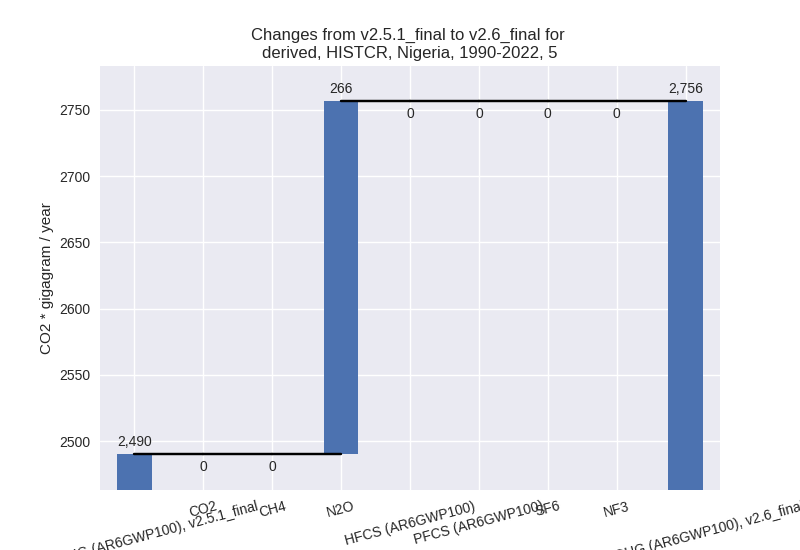
third party scenario (HISTTP):
Most important changes per time frame
For 2022 the following sector-gas combinations have the highest absolute impact on national total KyotoGHG (AR6GWP100) emissions in 2022 (top 5):
- 1: 1.A, CO2 with 8396.72 Gg CO2 / year (7.1%)
- 2: 4, CH4 with 350.62 Gg CO2 / year (0.8%)
- 3: 2, HFCS (AR6GWP100) with 205.69 Gg CO2 / year (1.5%)
- 4: 4, N2O with 60.84 Gg CO2 / year (2.8%)
- 5: 1.B.2, CO2 with -49.12 Gg CO2 / year (-0.5%)
For 1990-2022 the following sector-gas combinations have the highest absolute impact on national total KyotoGHG (AR6GWP100) emissions in 1990-2022 (top 5):
- 1: 1.A, CO2 with 557.86 Gg CO2 / year (0.9%)
- 2: 5, N2O with 266.32 Gg CO2 / year (10.7%)
- 3: 4, N2O with 6.37 Gg CO2 / year (0.4%)
- 4: 2, HFCS (AR6GWP100) with 6.23 Gg CO2 / year (0.1%)
- 5: 1.B.2, CO2 with -3.99 Gg CO2 / year (-0.0%)
Changes in the main sectors for aggregate KyotoGHG (AR6GWP100) are
- 1: Total sectoral emissions in 2022 are 267996.50
Gg CO2 / year which is 61.7% of M.0.EL emissions. 2022 Emissions have
changed by 3.2% (8347.60 Gg CO2 /
year). 1990-2022 Emissions have changed by 0.2% (553.87 Gg CO2 / year). For 2022 the
changes per gas
are:
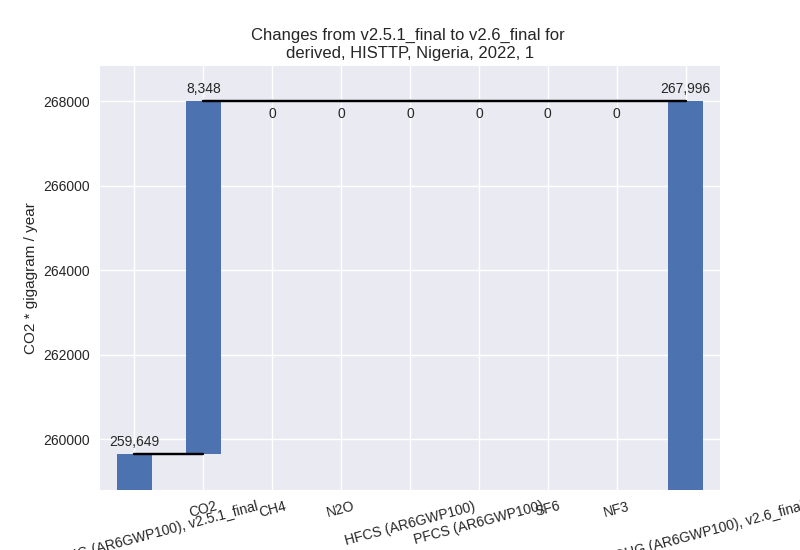
The changes come from the following subsectors:- 1.A: Total sectoral emissions in 2022 are 169633.66
Gg CO2 / year which is 63.3% of category 1 emissions. 2022 Emissions
have changed by 5.2% (8396.73 Gg CO2
/ year). 1990-2022 Emissions have changed by 0.6% (557.86 Gg CO2 / year). For 2022 the
changes per gas
are:
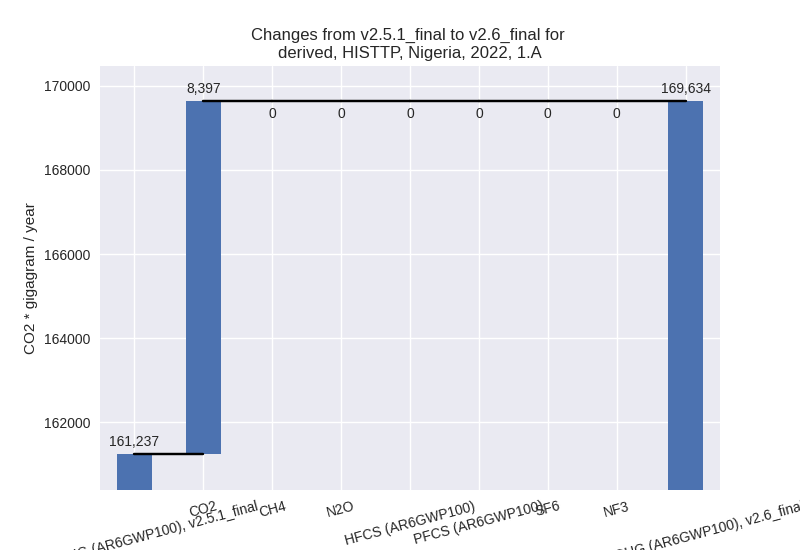
There is no subsector information available in PRIMAP-hist. - 1.B.1: Total sectoral emissions in 2022 are 11639.90 Gg CO2 / year which is 4.3% of category 1 emissions. 2022 Emissions have changed by 0.0% (0.00 Gg CO2 / year). 1990-2022 Emissions have changed by 0.0% (0.00 Gg CO2 / year).
- 1.B.2: Total sectoral emissions in 2022 are 86722.95 Gg CO2 / year which is 32.4% of category 1 emissions. 2022 Emissions have changed by -0.1% (-49.12 Gg CO2 / year). 1990-2022 Emissions have changed by -0.0% (-3.98 Gg CO2 / year).
- 1.A: Total sectoral emissions in 2022 are 169633.66
Gg CO2 / year which is 63.3% of category 1 emissions. 2022 Emissions
have changed by 5.2% (8396.73 Gg CO2
/ year). 1990-2022 Emissions have changed by 0.6% (557.86 Gg CO2 / year). For 2022 the
changes per gas
are:
- 2: Total sectoral emissions in 2022 are 29286.28 Gg CO2 / year which is 6.7% of M.0.EL emissions. 2022 Emissions have changed by 0.8% (232.77 Gg CO2 / year). 1990-2022 Emissions have changed by 0.2% (19.08 Gg CO2 / year).
- M.AG: Total sectoral emissions in 2022 are 85453.85 Gg CO2 / year which is 19.7% of M.0.EL emissions. 2022 Emissions have changed by 0.0% (0.00 Gg CO2 / year). 1990-2022 Emissions have changed by 0.0% (0.00 Gg CO2 / year).
- 4: Total sectoral emissions in 2022 are 47490.16 Gg CO2 / year which is 10.9% of M.0.EL emissions. 2022 Emissions have changed by 0.9% (417.18 Gg CO2 / year). 1990-2022 Emissions have changed by 0.0% (10.29 Gg CO2 / year).
- 5: Total sectoral emissions in 2022 are 3884.16 Gg
CO2 / year which is 0.9% of M.0.EL emissions. 2022 Emissions have
changed by 0.1% (4.27 Gg CO2 /
year). 1990-2022 Emissions have changed by 10.7% (266.32 Gg CO2 / year). For
1990-2022 the changes per gas
are:
